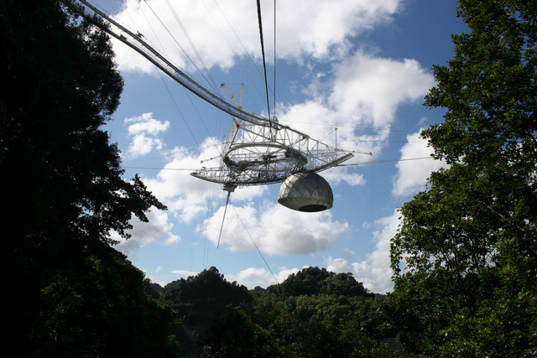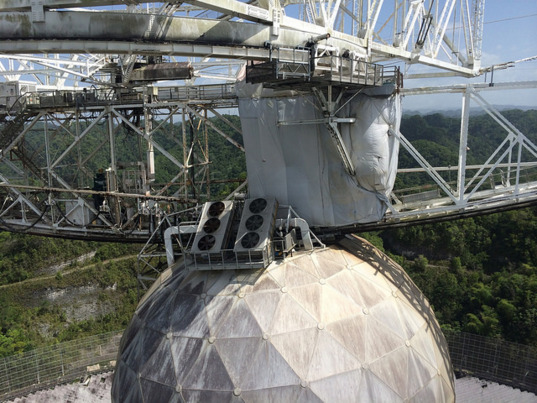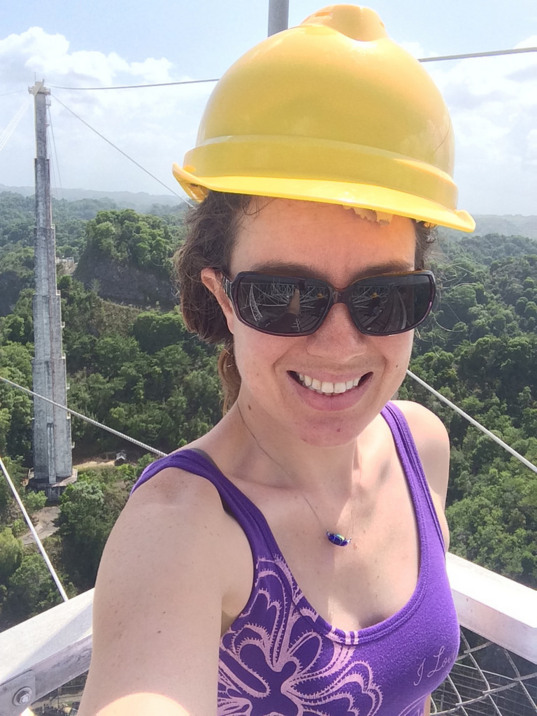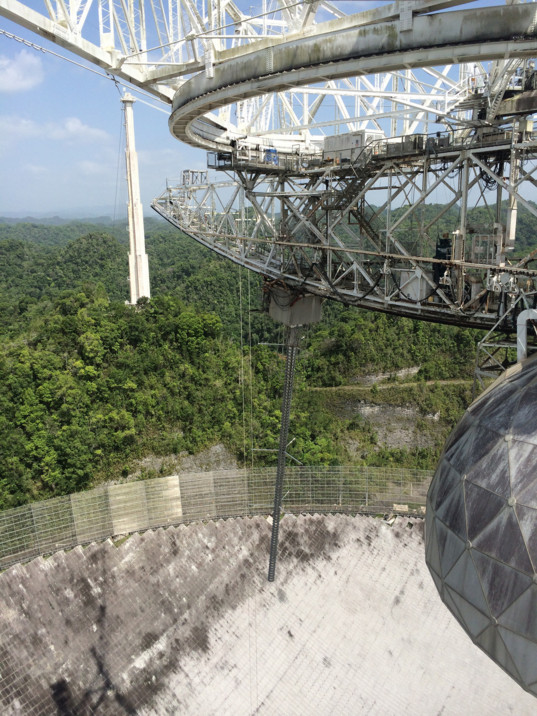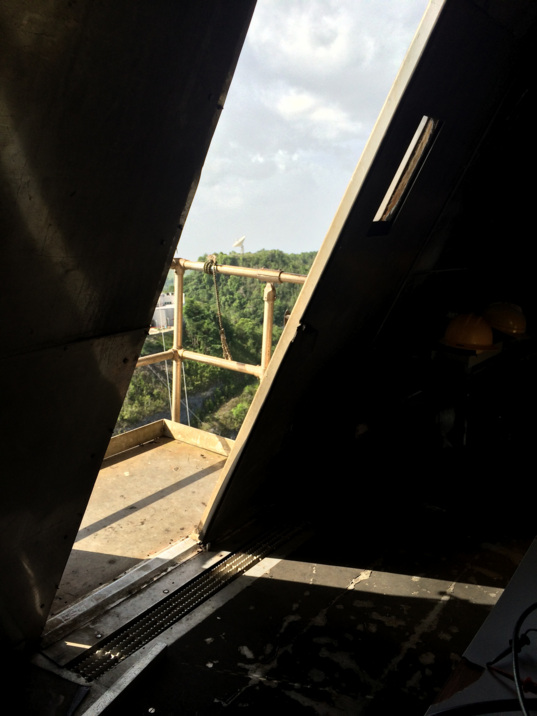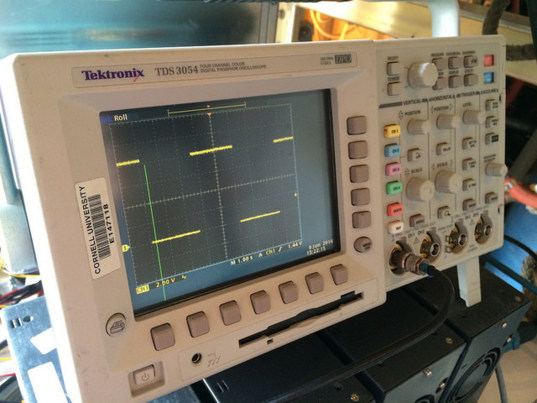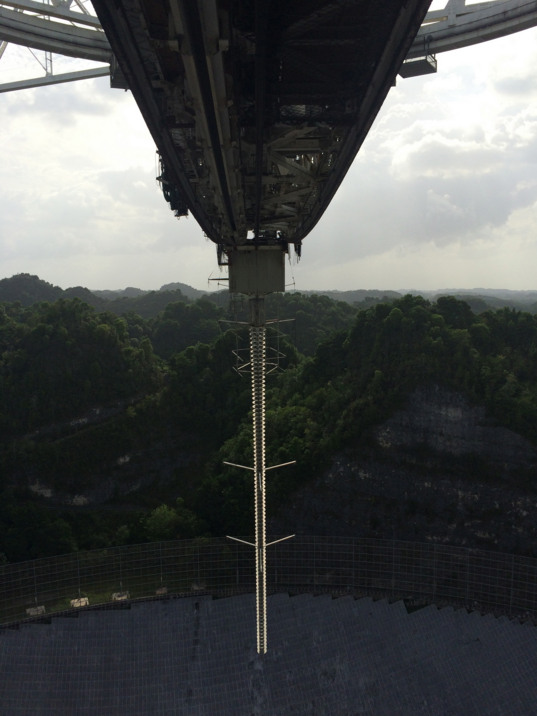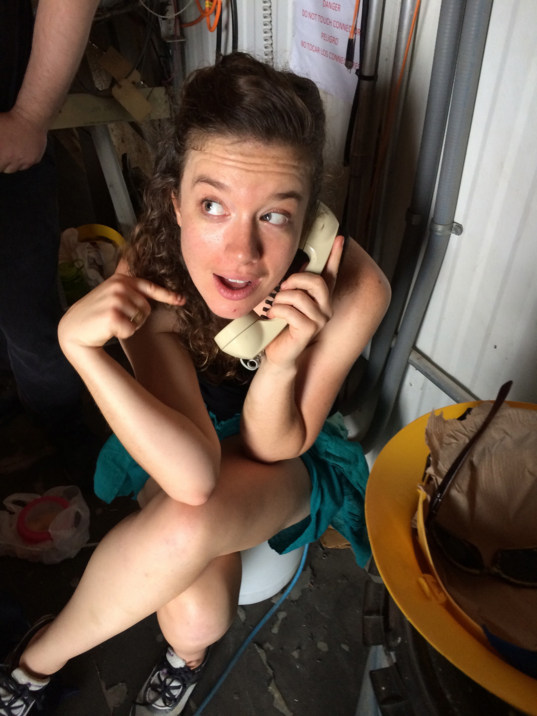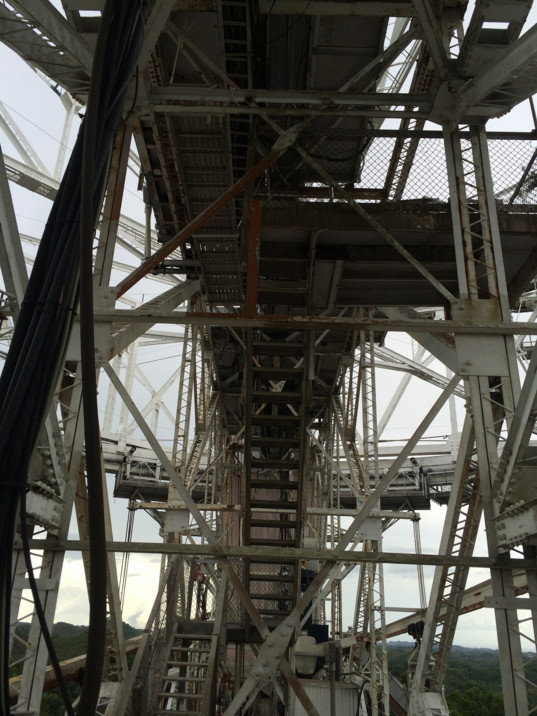Alessondra Springmann • Jul 16, 2014
How Arecibo Observatory Transmits to the ISEE-3 Spacecraft
"I VOLUNTEER AS TRIBUTE" is what Dana must have heard.
We were talking about the ISEE-3 spacecraft during lunch at Arecibo Observatory some day in early June, just another day on the job. The transmitter to talk to the spacecraft, the only one that was capable of communicating with ISEE-3 on June 9, required manual intervention to switch between transmit and receive. I probably said something to the extent of, "It sounds like fun to spend 2.5 hours sweating profusely in a barely ventilated dome in a confined space 152 meters (500 feet) in the air with a something-hundred-kilowatt transmitter requiring manual switching to talk to a spacecraft launched before my parents even considered having kids," or, "That might be fun to do later this week." Not, "Sure, I'll go spend my afternoon plugging and unplugging a cord in the name of science and archaic flight hardware". To microwave receiver specialist Dana Whitlow, one of the few people on site trained to do this switching, this meant "Absolutely, yes—today."
---
Arecibo Observatory rescued the ISEE-3 (International Sun/Earth Explorer 3, later repurposed as the International Comet Explorer) spacecraft back in the 1980s when the spacecraft used this 305-meter telescope as a data downlink. Why use Arecibo to contact this spacecraft as it became the first spacecraft to encounter a comet—Giacobini-Zinner—in 1985? Dust from the comet’s tail could degrade the signal enough such that the Deep Space Network tracking stations might not be able to detect the spacecraft’s signal. The gory details (PDF) live on; rapid fabrication of antennas and low-noise amplifiers had to occur before the spacecraft encountered the comet, as the frequencies it uses are just beyond the S-band radar used at Arecibo. Over ten years later in the 1990s, Arecibo radar rescued the SOHO spacecraft heading out to the sun by finding out its position when it looked like the mission could be lost. Unconventional spacecraft rescue techniques are a core competency here, even if we only have to do them every decade or so. Detecting and ranging small objects in space is a specialty.
Arecibo Observatory continues to be instrumental in communicating with spacecraft when traditional methods, such as the Deep Space Network, are unavailable. Similar to the can-do attitude of the 80s and 90s at Arecibo, the radio telescope rallied for the ISEE-3 spacecraft that required the 305-meter dish for communications. The spring 2014 effort involved a ham radio enthusiast in Germany building a power amplifier this spring for the ISEE-3 spacecraft reboot, and a group of software defined radio and archaic space hardware specialists figuring out a way to talk to this ancient space mariner with the power amps and some slick software hacks. A NASA space act agreement was signed. Things happened.
The usual method of transmitting and receiving at Arecibo is automated: software routines control switching from transmitter to receiver and back again. This process takes between six and eight seconds, depending on how nervous you want to make Dana. Motors drive a turret, a circular floor with instruments on it. Adding a new transmitter—this one the ISEE-3 power amplifier—requires either manual intervention to turn the floor between transmitting and receiving, or weeks of time to add the correct commands to the control software routines. Since the ISEE-3 project required quick implementation at Arecibo, we opted for manual switching between transmitting and receiving. Thus, at least two people needed to be in the telescope dome for when we’d communicate with the spacecraft, and at least one person needed to be in the control room directing the turret to rotate. This entire ballet was complex, and orchestrated over phone lines.
I was there for the earthquake right after an ISEE-3 transmit track when we saw and heard the dome shaking through video monitors as a member of the ISEE-3 group and two of our staff members were in the Gregorian dome suspended 150 meters (500 feet) above the dish. We lost our telescope time for the following hours (though later were able to observe comet 209P/LINEAR). (Even one of the observatory cats was watching the dome that day.) I was in the control room at Arecibo the second time they got the spacecraft to talk back to the ISEE-3 team.
These ISEE-3 project folks left Arecibo at the end of May, confident that their hardware and software was working at the radio telescope in the middle of the Puerto Rican jungle such that they could return to air conditioned comfort in California to remote control their spacecraft. But, they needed boots on the ground and hands on keyboards here. Without our number one hardware hacker Phil Perilat doing the software side of moving the instrument turret from transmit to receive, or Dana Whitlow, Anthony Ford, or Mike Nolan doing the manual hardware switching in the telescope dome, they'd be unable to talk to the spacecraft. And sometimes they needed extra help.
----
Lunchtime conversations at Arecibo Observatory range from the mundane ("These pork chops are awful this week. Save them for your dog; I'm getting a sandwich.") to scientific ("Another way to think of the ‘dunite dilemma’ is to consider that there may be an excess of olivine on Earth and that the asteroid belt is not actually depleted in this mineral.") to political ("...and that's how we saved planetary radar at the observatory...") to practical ("Can we schedule that seminar for a time when there isn’t a World Cup match on?").
Dana's usual co-conspirator, Anthony, was away at a workshop in Berkeley building radio spectrometers with our favorite SETI hardware guy in early June, so he needed someone to replace his usual partner in transmitter switching crime. My usual job description involves analyzing data and observing near-Earth asteroids. As far as my timesheet was concerned, the afternoon doing transmitter switching would be a volunteer boondoggle. I made a mental note to work more hours later in the week.
I finished the press release draft about asteroid 2014 HQ124 we'd observed the day prior, a beautiful asteroid and a real humdinger of a radar opportunity: Predicted signal to noise of this object was in the tens of thousands per transmit/receive cycle. Our images were stunning of this asteroid. My phone rang.
"Phil says we can go up now," said Dana Whitlow's pitched voice. I ran over to the control room, grabbed a hard hat, and shoved a paper towel into the rim to catch sweat. We teetered down the hill to the cable car, waiting for our ride to the platform. I adjusted my hardhat while we wait for the cable car to return, looking up at the telescope.
It was late afternoon and the sky was mostly clear. Blue patches were hazy with Saharan dust, blown thousands of miles across the Atlantic and keeping it from raining here. When it rains you can't go up to the platform as the risk of lightning makes the prospect of being so far up in the air dangerous. The afternoon looked clear, so we milled around the cable car building, waiting for our ride to the telescope platform.
Unlike in the James Bond film Goldeneye, the cable car doesn't take off very fast: it's a slow, steady ride up to the platform. James Bond could have run up and down the catwalk several times before 006 reached the telescope platform via cable car. A system of interlocks prevents the cable car from taking off without you. After pushing the "up" button, the motor engages, wheels begin to spin, and the car gently lurches (if that's at all possible) up a highly-greased cable. Away from the cable car motor housing, you can just hear the squish of the wheels on the greasy cable and the jungle sounds below.
The dome grew larger and larger as the cable car ride continued, and eventually we heard the chirp of the pulse tubes cooling the receivers in the dome. My first night riding up the cable car in the dark I saw fireflies lazily drifting in the darkness below the dish. A one-kilometer track runs around the dish, perfect for working on your 5k times or clearing your head after a day of working with data that predates your professional career. It’s hard to worry too much when you’re faced with views like this. And the roads that zigzag up karst slopes are good for reminding oneself that you can always use more hill work.
Docking was very smooth as the cable car nudged the platform. The smell of grease from the cable was strong. Dana worked his way through the interlocks: turn off the power, open a sliding gate, open the car doors, climb onto the platform. The first time on the platform I was shocked at how stable it was, but in retrospect, it makes sense: you can’t have your telescope moving every which way, or else it’ll be out of focus. Even at radio wavelengths, we still observe at a couple of bands with sizes measured in centimeters, requiring positional precision of the telescope structure.
There’s a set of stairs to go up, then a long staircase to the rotary joint. We crawled along the spiral ladder through the rotary joint and onto the azimuth arm: we are now on the part of the telescope that moves, driven by several motors and rotating on tracks. A couple flights of stairs down and we were on the arc of the azimuth arm, walking up a path that dead-ends at a set of tarps covering a painting project. We clambered down what could generously be called steps onto the dome carriage.
While some claim that the Gregorian dome looks rather geodesic, it’s not. The latitude lines run parallel, making it a lamella (you can explore a 3D model of the dome, too). The Gregorian dome lets us focus radio waves to a point, allowing for wider bandwidth studies of astronomical phenomena. Our ionosphere coworkers really only care about a short bandwidth of frequencies for their work, so they use the 30-meter-long 430 megahertz linefeed. Because of the painting project, the dome is tilted a little off from where you’d normally descend into its six-story space, so the first set of steps going down are pitched a little more down, the second set of steps going down are pitched a little up, and you eventually make it onto a landing that isn’t quite flat.
We skipped the transmitter room initially, but Dana left his backpack there; we would be returning for the bulk of our time. Down another flight and a half we entered the receiver room, plugging in a power supply on the C-band receiver. This room is air conditioned for the herd of receivers that rest on a turret, ready to rotate into place at the focus of the Gregorian dome. Power supply plugged in, we emerged from the receiver room and trek up to the transmitter room.
This room is always hot. It’s not air conditioned. It’s usually home to just two 500 kilowatt S-band klystrons, amplifiers for creating radio waves out of 65,000 volts at 33 amps. (That works out to 2 megawatts, but we dump half of that as waste heat. Thermodynamics.) Dana opened a door meant for hauling in equipment to ventilate the place. We were both in jeans, but he had the bright idea to wear a black shirt. I bet that I would be covered in grime by the end of the track.
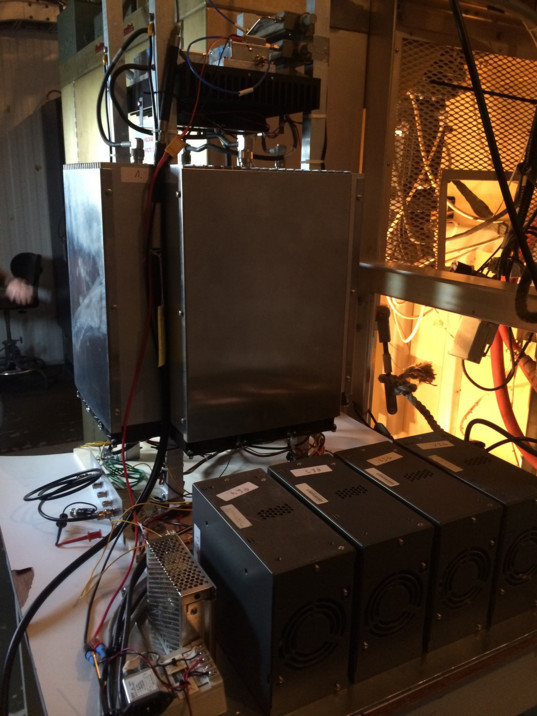
Alessondra Springmann
The power amplifier
The power amplifier, built in Germany, looks like something from the science fiction movie Primer. It looks relatively simple, surrounded by a number of heat sinks, but it’s the wiring and power supply that drive the amplifier.I spent the next 2.5 hours waiting for Dana to holler from a phone on the other side of the room, "PLUG IT IN" or "UNPLUG IT". I'd plug in the cord, jump down the ladder, twiddle down the attenuation on the power amplifier, then holler back, "PLUGGED IN, ATTENUATION Dowwnnnnn," dropping my voice on the last syllable. The other way, "UNPLUGGED, ATTENUATION UPPPPPPPPP!" to indicate I'd reduced the risk of the transmitter being fried between runs. The phone on my side of the room wasn’t working, hence the old-school communication methods.
To see the signals being transmitted to the spacecraft was great. I’d plug in the power amp, wait a few seconds, and watch the signal go from low to high. Sometimes they’d transmit long tones to the spacecraft while refining its known position. Other times they'd transmit commands to tell the spacecraft to spin faster by firing its thrusters.
After three sweaty hours in the dome, we cleaned up our ladders and 'scopes, then descended to the control room. I was stoked to have helped talk to the spacecraft. And also drenched in three hours’ worth of sweat.
Late afternoon at the observatory is lovely when the light is right. The sunlight hit the 430 MHz linefeed in just the right way to illuminate the tops of the concentric rings on the antenna, making it look even more like a Bond villain death ray than usual. Oh wait...
On the following Friday, some of my friends from MIT were set to visit, and I had asked for permission for them to visit the dome. I was chatting with my boss before he left and he said my friends could help with the manual transmitter switching, since Dana wasn't keen on doing it again, and I was one of two people on site aside from Dana trained to do the switching.
That Sunday afternoon, the four of us donned hard hats, grabbed a stick shift Suzuki Vitara and made our way up to the catwalk. The four of us clambered up the catwalk, pausing for occasional photos to the intense jealousy of tourists at the visitor center. We spent another sweaty afternoon unplugging and plugging back in a twistlock plug, adjusting attenuation on the power amp, and hearing over the phone distorted voices from California discussing with our software and hardware people how things were going.
"Hey, I just rebooted you,
And this is crazy,
But listen up, spacecraft,
And call me, maybe!"
(Apologies to Carly Rae Jepsen)
And because I'm a glutton for punishing myself and friends, I hauled along another set of visiting friends for transmitting later that week. Someone had filed down the plug prongs to remove corrosion, which I found out the hard way when I realized I’d sliced open my finger on the sharp prong edges and was bleeding. I managed to get the bleeding to stop and continued plugging and unplugging on Dana’s command over the phone; fortunately the one closest to the plug had been fixed so we didn’t need to yell across the control room. Everything was going great—we were getting faster on the turnaround between receiving and transmitting—until I pulled out the plug. The cable disconnected from the plug in my hand.
"We're off the air," confirmed Phil.
We found screwdrivers and took apart the plug. I was all set to put it back together but no one was going to find the wiring diagram as the electrician had gone home hours prior. Even worse, we didn't know which wire went to high/low/ground or even if the outlet was three phase, so we gave up, cleaned up, and came down the catwalk, slightly dejected, me with a cut finger from the twistlock plug on top of knowing I’d failed the ISEE-3 team.
Everyone I've spoken to has told me that the outlet needed a switch, and that there'd been a work order in for two weeks to install it, so I feel less bad. The following Monday, the plug was repaired and a switch installed; it's been working flawlessly for the last month as Arecibo continues to transmit and receive data for the ISEE-3 team.
What matters is that the ISEE-3 reboot team has their spacecraft data and was able to fire thrusters to spin it up, as well as improving its orbital predictions. Will the team be able to fire the engines in time before the spacecraft moves too far away? Will they find another telescope to talk to ISEE-3, albeit at a lower data rate since no one has a bigger available telescope than Arecibo? Will the hydrazine lines unclog?
My ISEE-3 plugging/unplugging days are over but I'm glad I got to contribute to a project beyond asteroid radar at Arecibo Observatory. Even though our spacecraft rescue efforts seem to happen about once a decade or so, Arecibo Observatory continues to be the best place in the universe to refine orbits of asteroids and spacecraft, and occasionally tell old space missions to get back on track.
Support our core enterprises
Your support powers our mission to explore worlds, find life, and defend Earth. You make all the difference when you make a gift. Give today!
Donate

 Explore Worlds
Explore Worlds Find Life
Find Life Defend Earth
Defend Earth


